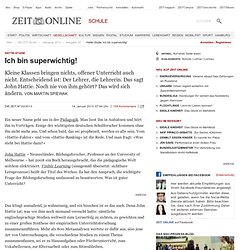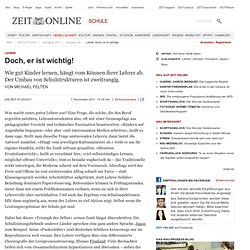

John Hattie et le Saint Graal de l’enseignement John Hattie, un chercheur néo-zélandais, a publié en 2009 un ouvrage, « Visible Learning », dont l’éditeur a fièrement rajouté sur la couverture de certaines rééditions un extrait d’un article du Times Education (2008) titré « Research reveals teaching’s Holy Grail », ce qui peut être traduit par « une recherche révèle le Saint Graal de l’enseignement ».

On ne saurait mieux indiquer comment ce travail et devenu un modèle de « bonne » recherche sur l’éducation, ce qui justifie qu’on lui consacre une série d’articles pour mieux en cerner l’intérêt et les limites. La raison de cet emballement pour Visible Learning réside en premier lieu dans la forme de ce travail, qui synthétise environ 800 méta-analyses, représentant plus de 50 000 études, portant sur des millions d’élèves, dans l’objectif d’identifier les facteurs de la réussite scolaire. Helmke, Interview zur Hattie-Studie. What can we learn from John Hattie. Ask not what works; instead ask: what works best?

‘Perhaps education’s equivalent to the search for the holy grail…’ (TES) “It is my ambition to say in ten sentences what others say in a whole book.” Friedrich Nietzsche, 1885 A casual glance through John Hattie’s CV shows just how prolific an educationalist he is. By 2007, he was on 8 editorial boards, including the British Journal of Educational Psychology, had written 12 books, supervised 168 PhD theses, published 546 papers, given over 700 public talks plus innumerable professional development sessions since 1989, and run workshops for thousands of teachers in thousands of schools.
Hattie has also collated the largest ever collection of evidence-based research in the educational world. His next book, Maximising Impact on Learning (2012), the biggest ever research project on teaching, took the numbers to over 900 meta-analyses over 18 years. “Now you see it…”: the magic of direct instruction and feedback. Ten sentences in his own words: 1. Making learning Visible (John Hattie) Auckland University Professor John Hattie has recently authored a study, based on research into 83 million students, studying effective teachers around the world and has come up with some reassuring results for creative teachers.

It's all about trusting relationships and 'oodles of feedback'. Note - it is not about national testing, our government's highly unoriginal plan. » L’apprentissage visible Espace TIC. J’ai (enfin) pris le temps de lire le livre de John Hattie, Visible Learning: a synthesis of over 800 meta-analyses relating to achievement (paru en 2009), disponible à la bibliothèque du Cégep.

Le livre est une synthèse de plus de 800 méta-analyses portant sur la réussite scolaire. Le portrait est global, appuyé et met le doigt sur la profession enseignante et le système scolaire avec une objectivité étonnante et parfois même déconcertante. Le regard posé est systématique. Hattie invite les intervenants en éducation à recueillir des données sur leurs façons de faire, puis à se demander : qu’est-ce qui fonctionne le mieux, pourquoi ça fonctionne, pour qui ça ne fonctionne pas? What can we learn from John Hattie. John Hattie préfère l'enseignement explicite aux pratiques constructivistes!
Teachers toolbox - Professor John Hattie's Table of Effect Sizes. Hattie says ‘effect sizes' are the best way of answering the question ‘what has the greatest influence on student learning?

'. An effect-size of 1.0 is typically associated with: • advancing learners' achievement by one year, or improving the rate of learning by 50% • a correlation between some variable (e.g., amount of homework) and achievement of approximately .50 • A two grade leap in GCSE, e.g. from a C to an A grade An effect size of 1.0 is clearly enormous! Below is Hattie's table of effect sizes. Terms used in the table (Interpreted by Geoff Petty) • An effect size of 0.5 is equivalent to a one grade leap at GCSE • An effect size of 1.0 is equivalent to a two grade leap at GCSE • ‘Number of effects is the number of effect sizes from well designed studies that have been averaged to produce the average effect size. • An effect size above 0.4 is above average for educational research Some effect sizes are ‘Russian Dolls' containing more than one strategy e.g.
Hattie-Studie: Ich bin superwichtig! Kleine Klassen bringen nichts, offener Unterricht auch nicht.

Entscheidend ist: Der Lehrer, die Lehrerin. Das sagt John Hattie. Noch nie von ihm gehört? Das wird sich ändern. An interview with Professor John HattieI'm a New Teacher. Like most Australian teachers, I first heard about Professor John Hattie’s work in an undergraduate lecture theater.

Despite the caffeine buzz and the limited nutrition damaging my body, I was impressed and inspired by the prolific work executed by Professor Hattie in the name of improving education outcomes in Australia and beyond. Professor Hattie is renowned for his research in student engagement and measurement of quality teaching and learning. For some reason his name stuck in my mind after that introductory lecture and I actually went home and researched and read some of his papers. What I read sparked my interest in the differentiation between expert teachers and novice teachers. I realised that age and experience do not necessarily determine the quality of your teaching practice. So, as you can imagine, I was delighted when Professor Hattie agreed to speak with me about the attributes that make a great teacher and the current issues in teaching retention. Lehrer: Doch, er ist wichtig!
Wie gut Kinder lernen, hängt vom Können ihrer Lehrer ab.

Der Umbau von Schulstrukturen ist zweitrangig. Speichern Drucken Twitter Facebook.